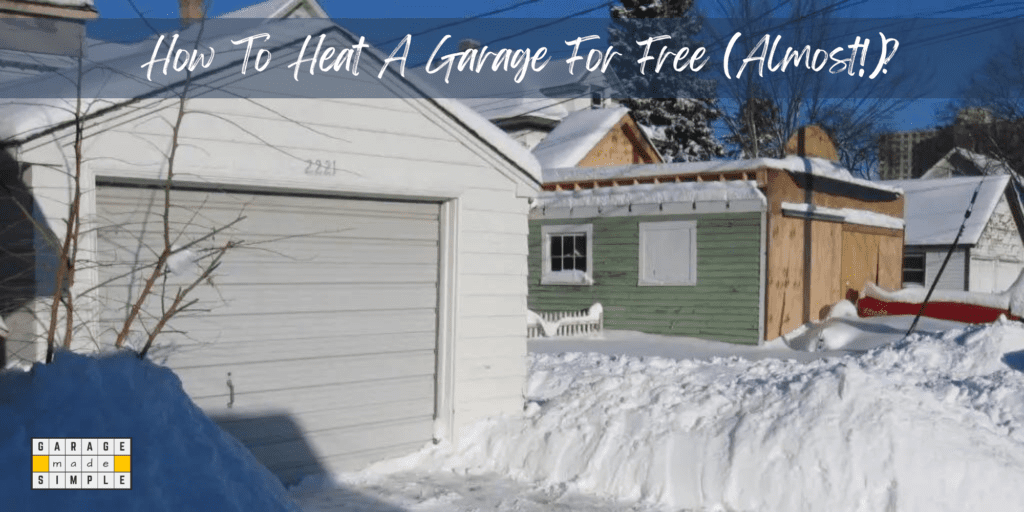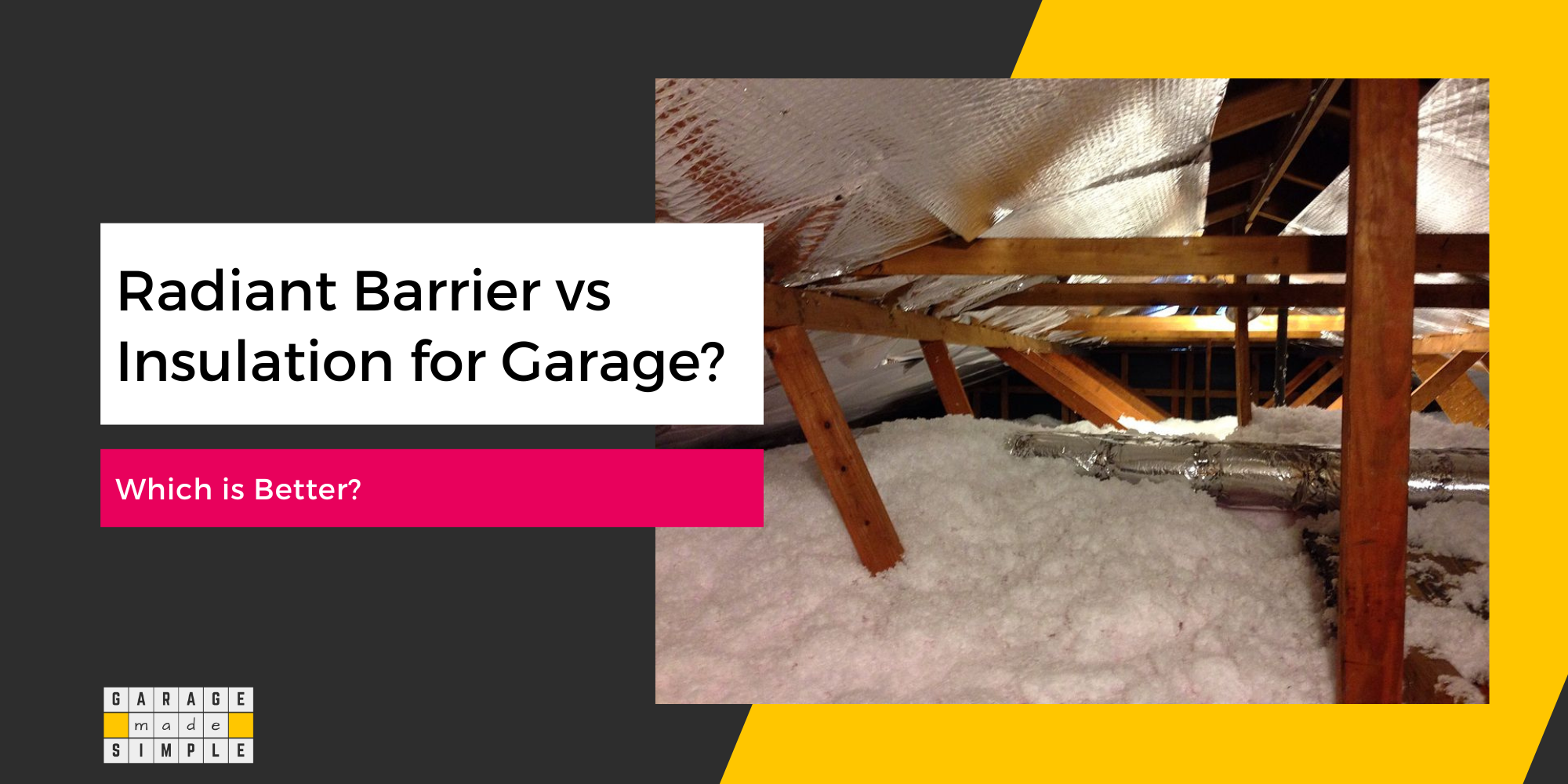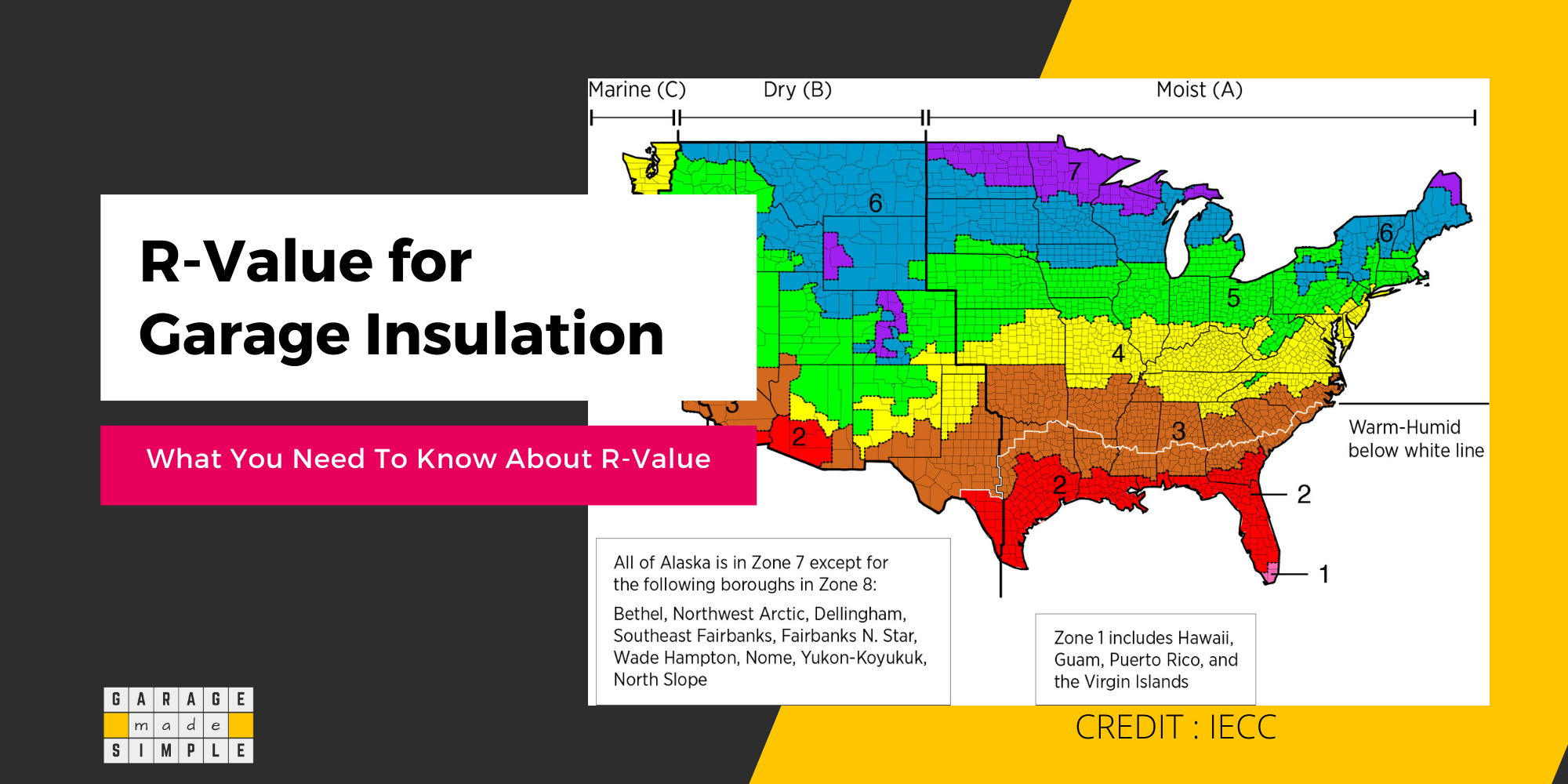How To Heat A Garage For Free (Almost!)? The Best 6 Ways!
garagemadesimple.com is a participant in the Amazon Services LLC Associates Program, an affiliate advertising program designed to provide a means for sites to earn advertising fees by advertising and linking to Amazon.com . The website is also an affiliate of a few other brands.

Do you have a detached garage that you like to use for an hour or two a day. Maybe you have a garage gym in it or you just like to potter around fixing your car. But the problem is it gets too cold and uncomfortable in the winters. You want to have a heated garage but you do not want to break the bank doing it. So, How To Heat A Garage For Free?
Nothing is free in this world! As they say there is no free lunch. But there are a few ways to heat a garage for free (well almost!). In this post I share 6 best ways to heat your garage either for free or on a very low budget!
There will be some initial expenditure in each case and there might be the odd maintenance cost once in a while. The first three ways are totally free, in the sense that there are no running costs. In the next three ways you will have a very small running cost.
1. Use Power from Solar Panels on the Garage Roof. It is Free!
Sun is a never ending source of clean energy. Sure, you know that. But did you know that Solar Power from your Detached Garage can heat up your garage during Winter for free?
You definitely can put solar panels on your detached garage roof, if it gets plenty of sunlight. Sure there is an initial installation cost. But guess what? The Fed gives you a tax credit and most states pitch in too!
You can save $600 per year on an average by installing a 3 kW Solar Power System on a Detached Garage roof. The system will generate 4000 kWh of electricity per year. The garage should have 200-240 square feet of south facing roof to accommodate 10-12 solar panels. The payback period is 7-10 years and the ROI is in the 10-30% range.
A typical 2 car garage (24’X24’) would need 4kW to heat it up. So your solar panel is delivering enough free power to heat your garage for 1000 hours. That is enough to run your garage heater for 6 hours a day for 5 months!
The complete Solar Energy system on you garage will consist of
- Solar Panels
- Inverter
- Panel Mounting
- Monitoring System
- Storage Batteries
Prices can and do vary across locations. This is partly based on the amount of sunlight a state gets. The more the sunshine hours the less the number of solar panels required for the same kWh energy generation.
Prices also depend on quality and the guarantees that manufacturers give. It is not advisable to go for the lowest price as it is a long term investment.
The good news is that the initial costs of solar power systems have been steadily declining. It has dropped from $6.00 per watt in 2010 to $2.50 in 2020.
And after the initial one time cost, it is basically free!
Want to know more about this option then do read my earlier blog post Will Solar Power From Detached Garage Really Save Money?
2. Harness the Heat Energy of the Sun through Color
The Sun is the greatest source of energy for the entire earth and it is entirely free. You can even harness some of this energy without using the high technology and set up cost of a solar panel.
Just use the right color!
The color of an object is basically the wavelength of the visible light that it is reflecting. White reflects almost all wavelengths while Black does not reflect any.
Black absorbs all the visible light. The light energy is converted to heat when absorbed.
This is why White is the coolest color and Black is the warmest.
A garage door forms a significant part of the facade of your home; upto 30%, for multiple car garages. Does your Garage Door face the south, south-east or south-west?
If so then the sun will be on the Garage Door for longer durations. Painting your Garage Door (preferably low sheen), will let the door absorb most of the sunlight. A free way of getting some extra heat during cold but sunny winters.
Why stop at the Garage Door? You can do the same with Garage Walls and the Garage Roof!
OK. I know that is taking it a bit too far! But you can still choose some eye pleasing dark colors like Storm Gray or Prussian Blue. They absorb a lot of heat from the sunlight too! And lighten up the mood with some white trim.
3. Insulation has No Running Cost but Prevents Heat Loss
Insulation is not seen as a source of heat. It is true insulation will not heat up the garage. But it sure will prevent the garage heat from being lost to the cold outdoors.
Heat not lost is heat gained. A penny saved is a penny earned. All your other garage heating devices have to work less harder. Your energy bills will most definitely be lower.
Your garage, especially a detached garage, has all 6 sides of the garage exposed to the elements. Insulating any bit helps, but for best results, insulate every side.
Garage Roof
When it comes to heat loss, the garage roof is possibly the biggest hole in your garage. Metal roofs are the worst culprits, because metal is an excellent conductor of heat. But even other types of roofing will leak huge amounts of heat, particularly on cold, windy winter nights.
Garage Door
Steel Garage Doors are the most popular, followed by Aluminum and Glass Doors. All these materials are good conductors of heat (read poor insulators!). Fortunately, you can get an insulated version of almost any type of garage door that you may wish to install.
You can quite easily install insulation on an uninsulated garage door. Garage Door Insulation Kits or Insulation Panels are available on Amazon, Home Depot or any big box building material store.
When you buy a fiberglass garage door insulation kit from a reputed manufacturer, such as Owen Corning, you will get 8 insulating panels 22″ H x 54″ W x 2.25″ thick. Each kit provides enough material to insulate a single car garage door up to 9-Feet wide.
Owens Corning Garage Door Insulation Kit
Owens Corning Garage Door Insulation Kit
Owens Corning’s Garage Door Insulation Kit is a complete kit comprised of (8) durable R-8 fiberglass insulation panels with a tough, washable white vinyl facing.
Each kit provides enough material to insulate a single car, garage door up to 9 feet wide x 7 feet 8 inches tall.
The installation is pretty simple and not much of DIY expertise & experience is required. Some cutting will be required if the insulation panel size is slightly bigger than the garage door panel.
The panels come with a unique fastening system. They are easy to fix as they use tape and snap on clips to hold the insulation panels in place on the non-insulated sectional garage door panels.
The method is quick to install and securely holds the insulation panels in place. The edges are tucked under the horizontal & vertical rails on the garage door panels.
Garage Walls
Do not forget to insulate the garage walls. In a detached garage, the garage walls are 3 out of the 6 sides that are exposed to the elements!
It is pretty simple to insulate garage walls as they are usually made of 2X4 wood studs and then drywall is used as sheathing. The space between the studs (the stud bay) is ideal for stuffing it with insulation batts of rockwool or fiberglass.
Owens Corning R 15 Kraft Faced Fiberglass Batt Fits 2X4 Stud Walls
Owens Corning 678 SQFT 10 Bags of R 15 Kraft Faced 15 by 93 Fiberglass Batt Fits 2X4 Walls
Owens Corning EcoTouch PINK Fiberglass Insulation with PureFiber Technology is a preformed, flexible blanket insulation. It is produced in R-values from 11 to 49, with thicknesses ranging from 31/2 inches to 14 inches. It is available unfaced, or faced with either a kraft or foil vapor retarder.
Garage Floor
Insulating the garage floor is as important as insulating any of the other sides. The garage floor sits on ground which can get pretty cold on a winter night. Concrete is a very cold material and not a great insulator.
If possible, use insulation panels before pouring the concrete slab. The insulation should be sandwiched between the grade base and the concrete slab. That is it should be in direct contact with the bottom of the concrete slab to be most effective.
If the garage floor does not have in-slab insulation, you can still use on-slab insulation. Insulated tiles or garage floor mats are also quite helpful.
Weather-stripping
Quite often, while insulating a detached garage, one overlooks the small cracks and little crannies through which the cold outside air leaks into the garage. Most of these leaks are around garage doors and windows.
Regularly check the seals, especially in fall, and replace them if they have gone brittle and cracked.
The above three ways on How To Heat A Garage For Free? Are actually FREE! There is no running or recurring cost involved. The next 3 ways are not FREE. They are CHEAP though and will get the job done!
4. Propane Garage Heater is Among the Cheapest Options
Electricity is generally more expensive than propane, when it comes to delivering the same amount of BTU.
The National fuel prices from The Department of Energy show that the cost of electricity is more than twice the cost of propane, when it comes to heating a house.
| PROPANE (Gal) | ELECTRICITY (kWH) | |
| BTU / Unit | 91,500 | 3,413 |
| Cost (cents/unit) | 291.3 | 21.4 |
| Cost (cents / 10,000 BTU) | 31.83 | 62.70 |
- Prices are average for NY State in May 2021
- A standard 2 car garage will need 12,000 to 24,000 BTU to heat up
Many models are available.
Quite often, you want the heating to be directed to a small space, such as around your workbench or workout zone. That way you do not waste energy, heating up the entire garage.
Mr. Heater 60,000 BTU Portable Propane Forced Air Heater
Mr. Heater 60,000 BTU Portable Propane Forced Air Heater
- QBT Technology – 50% Quieter than a standard propane heater
- 60,000 BTU Propane Forced-air Heater”
- Variable 30,000-60,000 BTU Output (Runs Up To 14 hrs on 20 lb. tank (low setting))
- Heats Up To 1,500 Sq.Ft.
- Continuous ignition
However, if you are looking for something a bit smaller and a lot more portable then Dyna-Glo HeatAround 360 Portable Propane Heater may be the one for you. It works great in the garage of course, but you can also use it on the patio or if you went out camping!
This snazzy propane heater uses either one or two 1-pound LP gas tanks, making it the perfect companion at tail-gate parties, camping and fishing trips, or for just hanging out on the deck this fall and winter. Select the 10,000 BTU (1 LP tank) or 18,000 BTU model (2 LP tanks) to best suit your heating needs.
5. Radiant Heating is Another Way to Heat your Garage for Almost Free
Radiant Heating is a technique of heating by evenly embedding heating elements within the surface or on the surface. In the case of concrete garage floors the elements are embedded within the concrete.
The heating elements can also be suspended from the ceiling of a garage. The heating element may be:
- Electrical Resistance Cables (Cheaper)
- Hot Water Pipes (Hydronic)
The element gets hot and radiates the heat to the surrounding space. Radiation heats up the objects in the garage (not the air). As a result it is more efficient.
The radiation elements can be placed only in the area required so that the heat energy is not wasted.
Let us say you have a 600 square foot garage. You may use 400 square feet to park two cars and the balance 200 square feet as space for your workshop or garage gym. You may choose to install radiant heating on the garage ceiling just over that 200 square feet.
You can also save energy cost by using water pipes and circulating hot water from a propane water heater. Propane as we have seen is half the cost of electricity.
Learn more from my earlier blog post Radiant Garage Floor Heating (Important Things You Need to Know)
6. An Electric Fan Heater Provides Warmth Where you Need It
An electric fan heater can be a cheap way of getting personal warmth in a cold garage. It is especially suitable if you have a small home office in your garage or have a comfortable reading nook in your garage library.
The electric fan heater can be small and elegant heating solution. The Stiebel Electric Wall Mounted Electric Fan Heaters, available at Sylvane, offer efficient, top-quality heating into spaces between 150 – 200 square feet.
A nichrome wire heating element and noise-reducing blower evenly spread warmth around your personal space in the garage.
However, if you are looking for a garage heater that has more power and can heat up your entire garage then you should seriously consider buying Dr. Infrared Heater DR-975 7500-Watt 240-Volt Hardwired Shop Garage Electric Heater, Wall/Ceiling Mounted with Remote Controlled Thermostat from Amazon.
Dr. Infrared Heater DR-975 is a Heavy-Duty Hardwired Shop Garage Heater. This 7500W heater can be the primary heat source for your garage. It is easy to install as it can be either wall or ceiling mounted.
The DR-975 uses spiral steel metal sheath electric heating elements with low sheath temperatures, providing uniform heat and long lasting product life. Additionally, a large, matched, dynamic fan provides maximum air flow with minimum turbulence and noise, gently distributing warmth throughout your garage.
Thank you very much for reading the post. I do hope you found it informative and useful.










